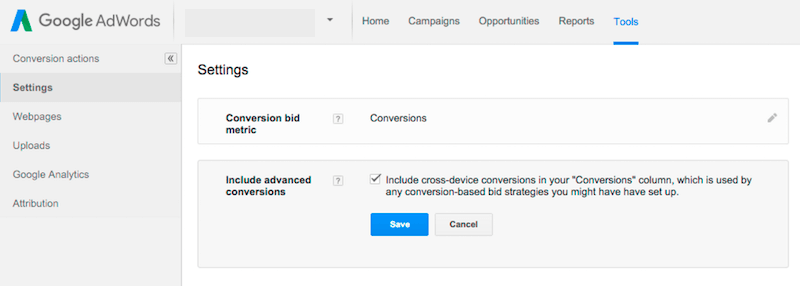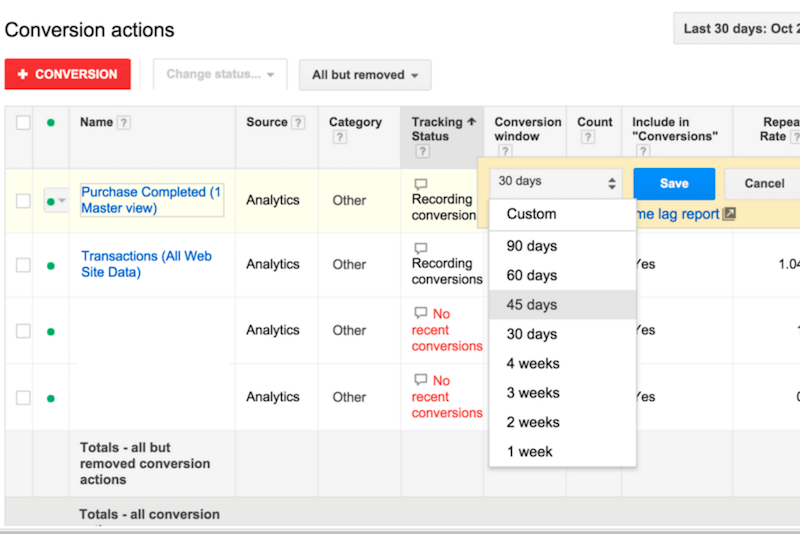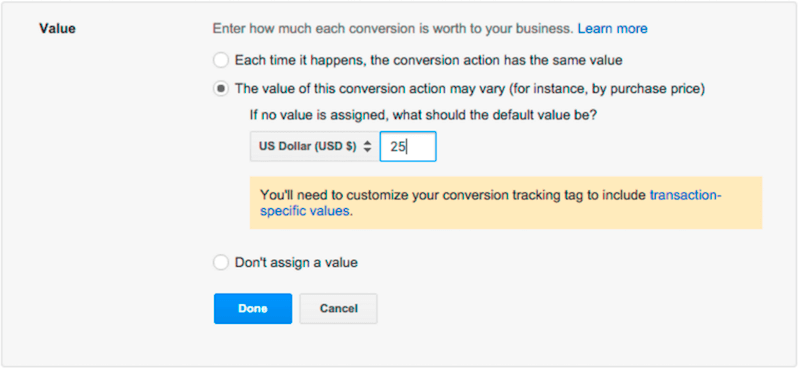Six Steps To AdWords Conversion Tracking Bliss
Conversions in AdWords have evolved a lot in recent months. Columnist and Googler Matt Lawson covers what you need to do to take full advantage.
To those of you who are still using Converted clicks as your primary success metric in AdWords: It’s time to change.
The era of the “Conversions” column is upon us. In the last few months, the “Conversions” column has gotten better and better. By following a handful of straightforward but oh-so-important steps, you can ensure that you’re using that column to the fullest of its abilities.
In case you haven’t given much thought to Converted clicks versus Conversions, here’s a good refresher. Basically, Converted clicks is very limited as a metric. It’s not customizable, you can’t segment or differentiate conversion types, and it doesn’t track some really cool stuff, like store visits or cross-device behavior. It only tracks whether or not a click led to a conversion (any type of conversion) later on.
The “Conversions” column, on the other hand, has a lot of great features to take advantage of. Let’s get into it.
A Recap Of Recent Changes
Back in September, Google introduced optimization settings for the “Conversions” column, along with the “All Conversions” column. Both changes are great, in my view, as you can now prioritize the stuff that’s most important to you for both reporting and bidding (in “Conversions”), while still keeping an eye on everything you’re tracking (in “All Conversions”). Search Engine Land Paid Media Reporter Ginny Marvin’s coverage of that announcement goes over the major takeaways.
In October, Google enabled reporting for cross-device conversions at the keyword level. This one was particularly exciting for me because it meant that it was now possible to include cross-device conversions in your “Conversions” column. Once you’ve checked the box to include cross-device conversions in that column, those conversions will be taken into account for your automated bidding. Here is Marvin’s take back when the announcement happened.
In short: The “Conversions” column is what you should be using (not the “Converted clicks” column), and you can take full advantage of the new features with a few simple steps.
1. Make The “Conversions” Column Your Single Source Of Truth
Why? Changing to a new column will be better for you long-term. It’s customizable and forward-looking.
If you’re still using Converted clicks in your reports, it’s time to move on. You and that column had a good run — great memories, wonderful months hitting performance goals, those glorious times visualizing Converted clicks in the Report Editor. Cherish the good times you had, but know that there’s an ice floe somewhere out there with your “Converted clicks” column’s name on it.
To make the shift to the new “Conversions” column, you’ll need to update your conversion bid metric settings.
2. Decide Which Of The Actions You’re Tracking Should Count In Your “Conversions” Column
Why? The “Conversions” column dictates your bidding, so use it to count the actions that deliver value to you. Any micro-conversions you track will still be reported in the “All Conversions” column.
I’m a big believer in tracking micro-conversions. I want to know every action people are taking on my site. But that doesn’t mean that each of those actions should dictate my bidding strategy.
By deciding what should and should not be counted in the “Include in ‘Conversions'” setting, you’ll have a great record of performance — one that’ll enable you to set the best bids possible. Then you can continue to keep an eye on All Conversions for supplementary insights.
(Quick note: If you can’t update “Include in ‘Conversions'” on your conversions tab, you should update your conversion bid metric first.)
3. Include Cross-Device Conversions In Your “Conversions” Column
Why? Users convert across devices. That’s simply how it is now. Plenty of journeys start as an ad click on one device and finish as a conversion on another. The better you are at observing that behavior, the better you can be at capitalizing on it with your AdWords strategy.
I think it’s so exciting that cross-device conversions can now be included in your “Conversions” column. Instead of doing your own calculations or piecing together some custom columns (which are great, by the way), you can tick one check box and include cross-device behavior in your standard performance reports. It’s a super-simple, yet incredibly valuable step, and it makes your “Conversions” column that much more useful, especially to use with automated bidding.
4. Determine Whether To Count All Instances Of A Conversion Or Only Unique Conversions
Why? Bidding should be to the true value of your conversions, so know which interactions deliver value the second, third or fourth time around. If it only matters to you to have that first interaction, then only count that first interaction.
Many long-time AdWords users may still think of this as one-per-click vs. many-per-click conversions. You’re tracking someone’s behavior on your site. Does it matter if someone does that thing multiple times, or do you only care if they did that thing once?
Generally, this breaks down to sales versus lead generation, but there are plenty of other use cases. As you update your “Conversions” column, it’s a good idea to also re-evaluate how you’re tracking repeat converters.
Remember, when you’re editing your conversion settings, click on the blue, hyperlinked name of each conversion you’re tracking, then you’ll be able to edit its settings.
5. Customize Your Conversion Windows And Values
Why? Time to purchase/conversion can vary, and so can the value of a conversion. Even for lead generation accounts, some leads might be more valuable than others. Longer conversion windows will give you more data to optimize with, and different conversion values will give you the chance to optimize more directly to revenue. Both of those things can be huge evolutionary leaps, depending on what’s most useful to your account.
Like one versus every instance of a conversion, conversion windows and values are most likely something that you’ve set up before. If you haven’t yet, now’s a great time to re-evaluate that. There are many things that are customizable for your conversion tracking, so it makes particular sense to customize time and money.
You can report on your conversion delay in AdWords to get a sense of how long it usually takes for conversions to occur. Look at your “from last click” numbers. If the last week or last few days of your conversion window are seeing a good number of conversions, it’s likely that you could be seeing even more conversions outside of the window you’re tracking. (Multi-Channel Funnels have this in Analytics, as well, if you want to view time lag across channels.)
6. Re-Evaluate Keyword Performance And Your Bids Once You’ve Made Any Changes To Your “Conversions” Column
Why? Keywords may receive more or less credit with updated conversion settings, especially for things like cross-device behavior. Your bids should be updated to reflect the value that you’re now capturing in your “Conversions” column.
By now, you’ll ideally be in full control of the types of actions to capture in your “Conversions” column. Once that hugely important job is complete, your bids should be updated to reflect that new value. Whether using manual or automated bidding, you’ll want to double-check what you’re willing to pay for different keywords. Be sure your bids match the way that you’ve chosen to track value.
Conclusion
Conversion tracking in AdWords keeps getting better and better. With a few changes, you can set yourself up to track all of the valuable actions that users can take after a click on your ad. Make the “Conversions” column your single source of truth.
Opinions expressed in this article are those of the guest author and not necessarily Search Engine Land. Staff authors are listed here.
Related stories






